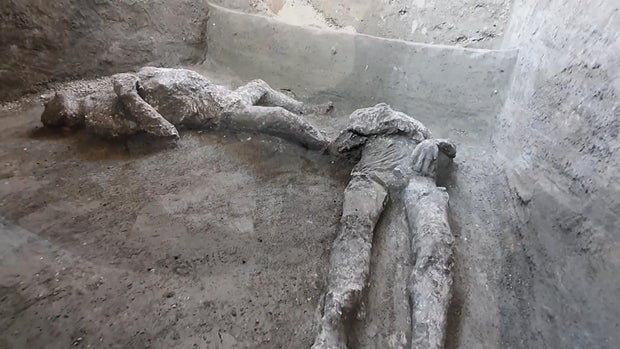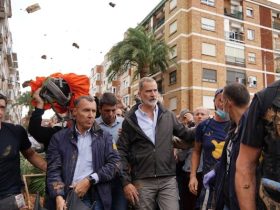When a volcanic eruption buried the traditional metropolis of Pompeii, the final determined moments of its residents had been preserved in stone for hundreds of years.
Observers see tales within the plaster casts later product of their our bodies, like a mom holding a toddler and two girls embracing as they die.
However new DNA proof suggests issues weren’t as they appear — and these prevailing interpretations come from wanting on the historical world by fashionable eyes.
“We had been capable of disprove or problem a few of the earlier narratives constructed upon how these people had been type of present in relation to one another,” mentioned Alissa Mittnik of the Max Planck Institute for Evolutionary Anthropology in Germany. “It opens up completely different interpretations for who these folks may need been.”
Mittnik and her colleagues found that the particular person regarded as a mom was really a person unrelated to the kid. And not less than one of many two folks locked in an embrace — lengthy assumed to be sisters or a mom and daughter – was a person. Their analysis was printed Thursday within the journal Present Biology.
CBS Information
The workforce, which additionally consists of scientists from Harvard College and the College of Florence in Italy, relied on genetic materials preserved for practically two millennia. After Mount Vesuvius erupted and destroyed the Roman metropolis in 79 A.D., our bodies buried in mud and ash ultimately decomposed, leaving areas the place they was. Casts had been created from the voids within the late 1800s.
Researchers targeted on 14 casts present process restoration, extracting DNA from the fragmented skeletal stays that combined with them. They hoped to find out the intercourse, ancestry and genetic relationships between the victims.
There have been a number of surprises in “the home of the golden bracelet,” the dwelling the place the assumed mom and baby had been discovered. The grownup wore an intricate piece of jewellery, for which the home was named, reinforcing the impression that the sufferer was a girl. Close by had been the our bodies of one other grownup and baby regarded as the remainder of their nuclear household.
DNA proof confirmed the 4 had been male and never associated to 1 one other, clearly exhibiting “the story that was lengthy spun round these people” was mistaken, Mittnik mentioned.
Researchers additionally confirmed Pompeii residents got here from various backgrounds however primarily descended from japanese Mediterranean immigrants – underscoring a broad sample of motion and cultural alternate within the Roman Empire. Pompeii is positioned about 150 miles (241 kilometers) from Rome.
The research builds upon analysis from 2022 when scientists sequenced the genome of a Pompeii sufferer for the primary time and confirmed the potential for retrieving historical DNA from the human stays that also exist.
“They’ve a greater overview of what is occurring in Pompeii as a result of they analyzed completely different samples,” mentioned Gabriele Scorrano of the College of Rome Tor Vergata, a co-author of that analysis who was not concerned within the present research. “We really had one genome, one pattern, one shot.”
Although a lot stays to be discovered, Scorrano mentioned, such genetic brushstrokes are slowly portray a more true image of how folks lived within the distant previous.
In August, archaeologists at Pompeii introduced they’d unearthed the stays of two extra victims — a man and a girl found inside what was probably the bed room of their dwelling, the place they’d turn out to be trapped as the remainder of the construction stuffed with particles. The girl was discovered on the mattress with a set of gold, silver and bronze cash, in addition to a pair of gold earrings, a pair of pearl earrings and different jewellery.
Earlier this yr, three researchers received a $700,000 prize for utilizing synthetic intelligence to learn a 2,000-year-old scroll that was scorched within the Vesuvius eruption.
The Herculaneum papyri encompass about 800 rolled-up Greek scrolls that had been carbonized through the 79 CE volcanic eruption that buried the traditional Roman city, in response to the organizers of the “Vesuvius Problem.”
The scroll’s writer was “in all probability Epicurean thinker Philodemus,” writing “about music, meals, and how one can get pleasure from life’s pleasures,” wrote contest organizer Nat Friedman on social media.
The scrolls had been present in a villa regarded as beforehand owned by Julius Caesar’s patrician father-in-law, whose principally unexcavated property held a library that might include 1000’s extra manuscripts.








